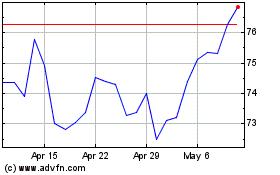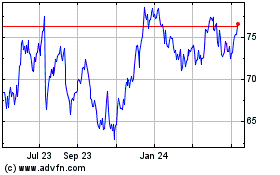Insurance Now a Riskier Business: New State Street Study Points to Foundational Shifts in Coming Year for Insurers Globally
May 22 2013 - 9:00AM
Business Wire
A perfect storm of shifting variables is pushing the insurance
sector to make changes in how it does business, according to the
most recent survey of insurance leaders released today by State
Street Corporation (NYSE:STT).
State Street’s study, conducted jointly with The Economist
Intelligence Unit, surveyed more than 300 insurance executives
globally and focused on the key industry issues and opportunities
facing the insurance industry and their preparedness in meeting
those challenges. The study, “Facing the Future: Blueprint for
Growth,” will be released next month and highlights three broad
categories affecting the insurance industry that include risk,
regulation and the restructuring of product offerings:
- Managing risk is a core competency for
insurance firms, and less than one-third of respondents say it
poses any difficulty for them, however, 80% of respondents say they
are actively considering increasing their allocation to alternative
strategies as they look for sources of additional yield, which may
add additional, more unfamiliar risk,
- More than 80% of insurers feel that
adapting to evolving regulation represents a challenge. Only 17%
view the regulatory environment as not posing a challenge at all;
and
- Ninety-three percent see restructuring
product offerings to bring new, innovative products to market
quickly as a challenge.
“The new normal of ultra low interest rates is putting pressure
on margins and evolving regulation is having a fundamental impact
on operating models,” said Joe Antonellis, vice chairman of State
Street. “While speed of execution is paramount, many insurance
companies are left with operational roadblocks and dependencies —
partly as a legacy of having expanded through years of mergers and
acquisitions.”
Seeking New Opportunities Brings New Areas of Risk
Against this backdrop of market complexity, 82 percent of
insurance leaders say that effectively allocating capital to the
most business critical priorities presents a challenge for them
today. Seeking additional capital, however, is creating additional
risk for insurance companies that they may not be able to
handle.
The challenge for the industry, however, is that insurers are
confronting new areas of risk with which they are typically less
familiar. These include reputational risk as they seek to appeal
directly to consumers rather than via intermediaries, and the risks
associated with utilizing alternative investments as part of their
broader investment strategy. The study finds that many insurers are
looking to alternatives amidst this low-yield environment and that
the risk associated with this asset class may pose a challenge:
- Nearly half (49%) are prioritizing
allocations to alternative strategies for action within the next 12
months,
- And 79% of insurers report that
investing in more complex asset classes is a challenge for their
firm.
Navigating the Changing Regulatory Environment
The evolving regulatory environment also poses additional
challenges. The study finds that insurers are divided when asked
about what the future holds. When considering the specific impacts
of new regulation, three-quarters of respondents say that ensuring
transparency of business policies and procedures presents a
challenge. Solvency II in Europe and similar initiatives elsewhere
underscore the focus on capital and transparency. In addition,
changing tax and regulatory regimes addressing transparency, risk
management and new capital requirements are resulting in further
significant changes to the market landscape.
Further exacerbating the regulatory challenge is international
expansion. Many insurance firms are eyeing global expansion as a
response to more muted growth prospects in domestic markets.
Increasing numbers of US and European companies are looking to
expand into Asia Pacific, and Asian firms are considering regional
expansion, despite the challenges of navigating multiple
jurisdictions and regulatory regimes. Insurers are focused on
global expansion, but 82 percent are concerned about their ability
to do this successfully and only 18 percent seeing no difficulty
related to expansion.
Restructuring of Products Brings Optimism
Despite the risks and challenges the sector is facing, there is
optimism. The State Street study finds that insurance firms are
confident in their outlook with 42 percent saying that insurers’
profitability will increase over the next five years. Insurers are
taking immediate action to recalibrate products for the current
macroeconomic environment, with 55 percent saying that they are
looking at re-pricing new business to adapt to market conditions,
including low interest rates, within the next 12 months.
Firms also see that demographics are changing and they must
pursue younger consumers if they want to grow. Traditional
distribution models are breaking down, and the internet is becoming
a key sales channel. Eighty-one percent of respondents say that
adapting distribution strategies to changing demographics is a
challenge.
“The need to revamp products, overhaul distribution strategies
and target new customers adds further complexity to challenges of
risk, regulation and restructuring,” continued Antonellis. “While
our research indicates that insurance firms are confident in their
outlook, they face a complex set of decisions. Those firms that can
successfully reposition themselves will have a significant
opportunity to gain a competitive edge. While there are certainly
headwinds facing the industry, there is still significant room for
growth and improvement of profitability. That is a very good thing
for the insurance industry.”
About the Survey
For a summary of the survey results please visit:
http://statestreet.com/ourbusiness/.
About State Street Corporation
State Street Corporation (NYSE: STT) is one of the world's
leading providers of financial services to institutional investors
including investment servicing, investment management and
investment research and trading. With $25.4 trillion in assets
under custody and administration and $2.2 trillion in assets under
management at March 31, 2013, State Street operates in more than
100 geographic markets worldwide, including the U.S., Canada,
Europe, the Middle East and Asia. For more information, visit State
Street’s web site at www.statestreet.com.
This AUM includes the assets of the SPDR Gold Trust (approx.
$62.7 billion as of March 31, 2013), for which State Street Global
Markets, LLC, an affiliate of State Street Global Advisors, serves
as the marketing agent.
State Street (NYSE:STT)
Historical Stock Chart
From Jun 2024 to Jul 2024

State Street (NYSE:STT)
Historical Stock Chart
From Jul 2023 to Jul 2024
